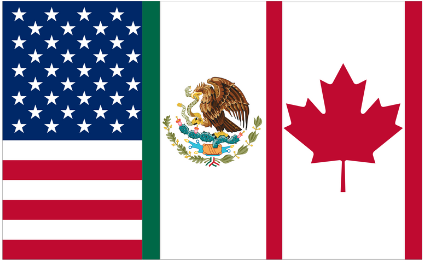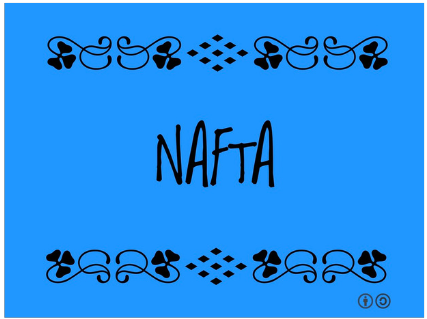




An Overview of NAFTA
The Trade and Tariff Act of 1984 paved the way for a free trade agreement between the US, Mexico and Canada. NAFTA, also known as the North American Free Trade Agreement, is an agreement among the United States, Canada, and Mexico. It is referred to as the tripartite trading bloc of countries of North America. This agreement came into effect in 1994. It is a successor to the Free Trade Agreement between the United States and Canada and NAFTA trumps the Free Trade Agreement.

NAFTA - Agreement Signed Between the United States (left), Mexico (middle), and Canada (right).
What is NAFTA?
The agreement was implemented between the United States, Mexico, and Canada to promote trade. NAFTA added two side agreements, the NAALC (North American Agreement on Labour Cooperation) and NAAEC (North American agreement on environmental cooperation). It focused on eliminating trade tariffs on agricultural products, automobiles, and textiles. This agreement also protected intellectual property rights and removed the restrictions on investment among these three countries. It has also deepened the political relationship among the three signatory countries.

NAFTA - North American Free Trade Agreement
Controversy Related to NAFTA
Since its inception, NAFTA has been the centre of controversy. It was believed that the lower tariffs would help in increasing the profits, but according to the trade and labour unions of the United States and Canada, their jobs are in danger because of the fear of shifting to Mexico due to lower labour costs there.
Moreover, former US President Donald Trump contended that the trade deficit with Mexico and the loss of American jobs are due to NAFTA. For this, he intended to revise the trade agreement with Mexico.
Why was NAFTA in the News?
Due to controversies and issues in the agreement, the three countries talked about overhauling the agreement. In January 2017, it was agreed that a revised agreement would be signed between the countries. The new agreement will address the issues of labour, environment, and the changes in the business environment. It also announced that the deal would make this agreement fairer. The US and Mexico had a consensus, but Canada was not showing any signs of interest.
Canada opposed the new consensus because of the following reasons:
The barriers to the import of dairy placed by Canada. This is because the country wanted to ensure that imports did not harm its farmers.
Who is Canada related to movies, books, and other media? Canada wanted to ensure that its media industries were not overrun by big US rivals.
The trade dispute settlement mechanism.
Despite the tussle between US and Canada, the negotiators have been trying to negotiate the deal because the US wants Canada and Mexico to be a part of it. It is important for the United States because Canada is one of its major export destinations for them.
Later, in September 2018, NAFTA was replaced by USMCA (United States – Mexico – Canada agreement). USMCA took effect on 1 July 2020.
Benefits of NAFTA
The NAFTA benefits are as follows:
It increased cross-border trade and commerce in North America and investment among the three member countries. It quadrupled trade and boosted the economic growth of the countries involved.
It benefited small and medium businesses because of lowered costs and allowed the company to do business in a foreign country without a physical presence.
It established a proper framework for businesses, such as protecting intellectual property rights, establishing dispute resolution mechanisms, and implementing labour and environmental safeguards.
The agreement benefited not only the businesses but also the customers as the prices of the products were lowered. A lower tariff also reduced the import prices, which reduced the risk of inflation and kept the interest rate low, reducing the prices of the products.
Increase in foreign direct investment in Canada and Mexico, which also boosted the profit for businesses based in the US by giving them opportunities for developing and exploring the market. The agreement created a level playing field for the companies within the borders of the three countries.

Agreement of free trade between countries paves the way for other countries to enter the globalised world. Such agreements create a unified world.
Summary
The North American Free Trade Agreement (NAFTA) is both an improving and controversial measure. Though it improved the trade and investment between the three countries, on the other hand, it hurt the economy in terms of employment and environment. The agreement is a matter of debate as there were significant gains and also some losses. The engagement of the three North American countries has laid the foundation of free trade and globalisation for the world.
With the changing business environment, it is important to update the old agreements and transform them into new ones to keep in line with the current changes. The new renegotiated agreement between the United States, Mexico, and Canada, i.e., USMCA, has included the earlier loopholes, to improve the trade agreement.
FAQs on NAFTA: North American Free Trade Agreement Overview
1. What was the primary purpose of the North American Free Trade Agreement (NAFTA)?
The primary purpose of NAFTA was to create a free trade zone between its member countries: the United States, Canada, and Mexico. The main goals were to eliminate tariffs and non-tariff barriers to trade and investment, promote conditions of fair competition, and establish a framework for future trilateral, regional, and multilateral cooperation to expand the agreement's benefits.
2. What were the main advantages of NAFTA for its member nations?
NAFTA provided several key advantages for its members, leading to significant economic integration. These benefits included:
Increased Trade Volume: Trilateral trade between the member nations more than tripled, fostering economic growth.
Economic Growth: The agreement contributed to a rise in the Gross Domestic Product (GDP) for all three countries.
Foreign Direct Investment (FDI): It significantly boosted investment, particularly U.S. investment in Mexican manufacturing plants (maquiladoras).
Lower Consumer Prices: The removal of tariffs led to cheaper imported goods for consumers in all three nations.
3. What were the significant disadvantages or criticisms of NAFTA?
Despite its benefits, NAFTA faced several major criticisms, including:
Job Losses: Critics in the U.S. argued that the agreement led to the loss of manufacturing jobs, as companies moved production to Mexico to take advantage of lower labour costs.
Impact on Mexican Farmers: Mexican farmers struggled to compete with highly subsidised agricultural products from the U.S., leading to economic hardship in rural areas.
Poor Working Conditions: Concerns were raised about substandard labour conditions and low wages in Mexican factories.
Environmental Damage: The focus on cost reduction led to concerns about increased pollution and deforestation, particularly along the U.S.-Mexico border.
4. How is the USMCA different from NAFTA?
The United States-Mexico-Canada Agreement (USMCA), which replaced NAFTA in 2020, introduced several key updates. The primary differences include stricter rules of origin for the automotive industry, enhanced labour and environmental protections, new provisions for digital trade and intellectual property, and improved access for U.S. dairy products to the Canadian market. Essentially, the USMCA was designed to modernise the trade relationship to reflect the 21st-century economy.
5. What is the key difference between a free trade area like NAFTA and a customs union?
The key difference lies in their approach to external trade. A free trade area, such as NAFTA, eliminates tariffs and trade barriers among its members, but each country maintains its own independent trade policies and tariffs with non-member nations. In contrast, a customs union not only allows free trade among members but also requires them to adopt a common external tariff policy towards countries outside the union.
6. How did NAFTA impact specific industries like automotive and agriculture?
NAFTA had distinct impacts on different sectors. In the automotive industry, it created highly integrated cross-border supply chains, allowing parts to move tariff-free between countries for assembly, which lowered costs but was criticised for shifting jobs. In agriculture, it boosted U.S. exports to Mexico and Canada, but it negatively affected many small-scale Mexican farmers, especially corn producers, who could not compete with large, subsidised U.S. farms.
7. Why are trade agreements like NAFTA important for a country's economy?
Trade agreements are important as they provide a formal structure for international commerce, which can lead to several economic benefits. They promote specialisation and efficiency by allowing countries to focus on producing goods where they have a comparative advantage. By reducing trade barriers, they can lower prices for consumers, increase market access for domestic producers, and attract foreign direct investment, all of which can stimulate overall economic growth and foster stronger diplomatic ties.





















